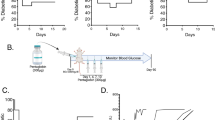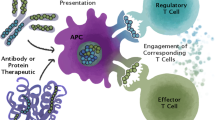Abstract
We report on long-term delivery of an interferon-γ (IFNγ) inhibitory protein by intramuscular (i.m.) gene therapy. IFNγ is a cytokine that plays an important role in many inflammatory disorders, including autoimmune insulin-dependent diabetes mellitus (IDDM) in NOD mice and (in various strains) multiple low-dose streptozotocin (STZ)-induced diabetes (MDSD). By cDNA insertion into plasmid VICAL VR-1255 we constructed an expression vector encoding a soluble IFNγ receptor/IgG1 heavy chain (all murine) fusion protein (IFNγR/IgG1). This protein is secreted as a homodimer and neutralizes IFNγ in vitro. We show that i.m. injections of this vector as naked DNA in mice results in secretion of IFNγR/IgG1, with serum levels exceeding 100 ng/ml for months after treatment. These levels are sufficient to neutralize IFNγ in vivo, and to prevent either MDSD or cyclophosphamide (CYP)-accelerated diabetes in NOD mice, which are both characterized by systemic release of IFNγ. In these diseases gene therapy considerably reduces inflammation in the islets of Langerhans (insulitis). Also, circulating IFNγR/IgG1 blocked IFNγ-enhanced nitric oxide production by peritoneal macrophages. The fusion protein is constructed from nonimmunogenic self elements, avoiding a neutralizing immune response and making it suitable for prolonged therapy of numerous inflammatory disorders.
This is a preview of subscription content, access via your institution
Access options
Subscribe to this journal
Receive 12 print issues and online access
$259.00 per year
only $21.58 per issue
Buy this article
- Purchase on Springer Link
- Instant access to full article PDF
Prices may be subject to local taxes which are calculated during checkout




Similar content being viewed by others
References
De Maeyer E, De Maeyer-Guignard J . Interferons. In: Thomson A (ed) . The Cytokine Handbook Academic Press: San Diego 1998 491–516
Billiau A . Interferon-gamma in autoimmunity Cytokine Growth Factor Rev 1996 7: 25–34
Lucey DR, Clerici M, Shearer GM . Type 1 and type 2 cytokine dysregulation in human infections, neoplastic, and inflammatory diseases Clin Microbiol Rev 1996 9: 532–562
Yoon JW, Jun HS, Santamania P . Cellular and molecular mechanisms for the initiation and progression of beta cell destruction resulting from the collaboration between macrophages and T cells Autoimmunity 1998 27: 109–122
Delovitch TL, Singh B . The nonobese diabetic mouse as a model of autoimmune diabetes: immune dysregulation gets the NOD Immunity 1997 7: 727–738
Campbell IL, Kay TW, Oxbrow L, Harrison LC . Essential role for interferon-gamma and interleukin-6 in autoimmune insulin-dependent diabetes in NOD/Wehi mice J Clin Invest 1991 87: 739–742
Nicoletti F et al. The effects of a nonimmunogenic form of murine soluble interferon-gamma receptor on the development of autoimmune diabetes in the NOD mouse Endocrinol 1996 137: 5567–5575
Rothe H et al. Cyclophosphamide treatment of female NOD mice causes enhanced expression of inducible nitric oxide synthase and interferon-gamma, but not IL-4 Diabetologia 1994 37: 1154–1158
Piccirillo C, Chang Y, Prud’homme GJ . Transforming growth factor beta-1 (TGF-beta-1) somatic gene therapy prevents autoimmune disease in NOD mice J Immunol 1998 161: 3950–3956
Charlton B, Bacelj A, Slattery RM, Mandel TE . Cyclophosphamide-induced diabetes in NOD/WEHI mice. Evidence for suppression in spontaneous autoimmune diabetes mellitus Diabetes 1989 38: 441–447
Wolff JA et al. Long-term persistence of plasmid DNA and foreign gene expression in mouse muscle Hum Mol Genet 1992 1: 363–369
Raz E et al. Modulation of disease activity in murine lupus erythematosus by cytokine gene delivery Lupus 1995 4: 286–292
Giladi E et al. Transforming growth factor-beta gene therapy ameliorates experimental colitis in rats Eur J Gastroenterol Hepatol 1995 7: 341–347
Haworth C, Maini RN, Feldmann M . Cytokine and anti-cytokine therapy. In: Thomson A (ed) . The Cytokine Handbook Academic Press: San Diego 1998 777–801
Hartikka J et al. An improved plasmid DNA expression vector for direct injection into skeletal muscle Hum Gene Ther 1996 7: 1205–1217
Migliorini P, Corradin G, Corradin SB . Macrophage NO2− production as a sensitive and rapid assay for quantitation of murine IFN-gamma J Immunol Meth 1991 139: 107–114
Havell EA . Purification and further characterization of an anti-murine interferon-gamma monoclonal neutralizing antibody J Interferon Res 1986 6: 489–497
Cockfield SM, Ramassar V, Urmson J, Halloran PF . Multiple low dose streptozotocin induces systemic MHC expression in mice by triggering T cells to release IFN-gamma J Immunol 1989 142: 1120–1128
Prud’homme GJ . Cytokines and autoimmunity. In: Bona CA, Siminovitch KA, Zanetti M, Theofilopoulos AN (eds) . The Molecular Pathology of Autoimmune Diseases Harwood Academic Publishers: Chur, Switzerland 1993 149–168
Prud’homme GJ . Quantitative polymerase chain reaction analysis reveals marked overexpression of IL-1-beta, IL-10, and interferon-gamma in the lymph nodes of lupus-prone mice Mol Immunol 1995 32: 495–503
Sarvetnick N et al. Loss of pancreatic islet tolerance induced by beta-cell expression of interferon-gamma Nature 1990 346: 844–847
Wang B et al. Interferon-gamma impacts at multiple points during the progression of autoimmune diabetes Proc Natl Acad Sci USA 1997 94: 13844–13849
Kürschner C, Ozmen L, Garotta G, Dembic Z . IFN-gamma receptor-Ig fusion proteins. Half-life, immunogenecity, and in vivo activity J Immunol 1992 144: 4096–4100
Baquerizo H, Rabinovitch A . Interferon-gamma sensitizes rat pancreatic islet cells to lysis by cytokines and cytotoxic cells J Autoimmunity 1990 3 (Suppl. 1): 123–130
Pukel C, Baquerizo H, Rabinovitch A . Destructive of rat islet cell monolayers by cytokines. Synergestic interactions of interferon-gamma, tumor necrosis factor, lymphotoxin, and IL-1 Diabetes 1988 37: 133–136
Heitmeier MR, Scarim AL, Corbett JA . Interferon-gamma increases the sensitivity of islets of Langerhans for inducible nitric-oxide synthase expression induced by IL-1 J Biol Chem 1997 272: 13697–13704
McDaniel ML et al. Cytokines and nitric oxide in islet inflammation and diabetes Proc Soc Exp Biol Med 1996 211: 24–32
Cetkovic-Cvrlje M, Eizirik DL . TNF-alpha and IFN-gamma potentiate the deleterious effects of IL-1 beta on mouse pancreatic islets via generation of nitric oxide Cytokine 1994 6: 399–406
Heller B et al. Analysis of oxygen radical toxicity in pancreatic islets at the single cell level Biol Chem Hoppe-Seyler 1994 375: 597–602
Lee KU, Amano K, Yoon JW . Evidence for initial involvement of macrophages in development of insulitis in NOD mice Diabetes 1988 37: 989–991
Haak-Frendscho M et al. Inhibition of interferon-gamma by an interferon-gamma receptor immunoadhesin Immunol 1993 79: 594–599
Peppel K, Crawford D, Beutler B . A tumor necrosis factor (TNF) receptor-IgG heavy chain chimeric protein as a bivalent antagonist of TNF activity J Exp Med 1991 174: 1483–1489
Kürschner C, Garotta G, Dembic Z . Construction, purification, and characterization of new interferon gamma inhibitor proteins J Biol Chem 1992 267: 9354–9360
Capon DJ et al. Designing CD4 immunoadhesins for AIDS therapy Nature 1989 337: 525–531
Wells KE et al. Immune responses, not promoter inactivation, are responsible for decreased long-term expression following plasmid gene transfer into skeletal muscle FEBS Letts 1997 407: 164–168
Coligan JE et al. Current Protocols in Immunology. John Wiley and Sons: New York, 1991, pp 8.10.1–8.10 17
Liang L, Beshay E, Prud’homme GJ . The phosphodiesterase inhibitors pentoxifylline and rolipram prevent diabetes in NOD mice Diabetes 1998 47: 570–575
Herold KC et al. CD28/B7 costimulation regulates autoimmune diabetes induced with multiple low doses of streptozotocin J Immunol 1997 158: 984–991
Author information
Authors and Affiliations
Rights and permissions
About this article
Cite this article
Prud’homme, G., Chang, Y. Prevention of autoimmune diabetes by intramuscular gene therapy with a nonviral vector encoding an interferon-gamma receptor/IgG1 fusion protein. Gene Ther 6, 771–777 (1999). https://doi.org/10.1038/sj.gt.3300879
Received:
Accepted:
Published:
Issue Date:
DOI: https://doi.org/10.1038/sj.gt.3300879
Keywords
This article is cited by
-
Cationic Nanomicelles for Delivery of Plasmids Encoding Interleukin-4 and Interleukin-10 for Prevention of Autoimmune Diabetes in Mice
Pharmaceutical Research (2012)
-
Gene therapy of diabetes using a novel GLP-1/IgG1-Fc fusion construct normalizes glucose levels in db/db mice
Gene Therapy (2007)
-
Plasmid-based gene therapy of diabetes mellitus
Gene Therapy (2007)
-
In vivo expression of GLP-1/IgG-Fc fusion protein enhances beta-cell mass and protects against streptozotocin-induced diabetes
Gene Therapy (2007)
-
DNA vaccination with an insulin construct and a chimeric protein binding to both CTLA4 and CD40 ameliorates type 1 diabetes in NOD mice
Gene Therapy (2005)



